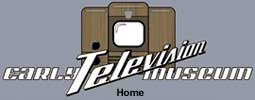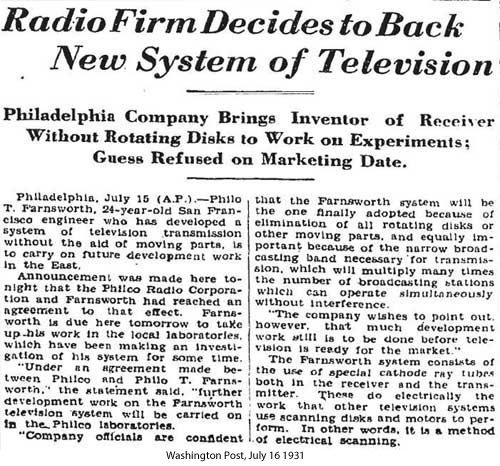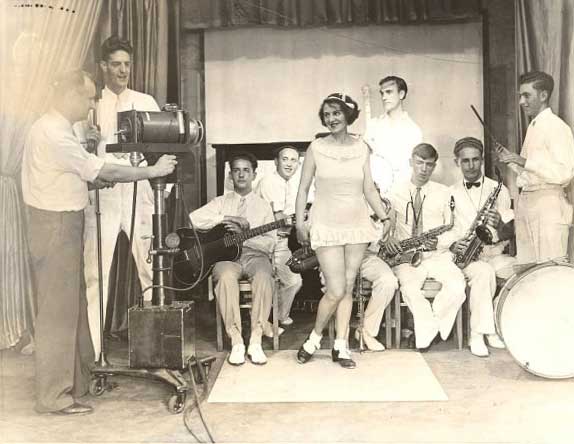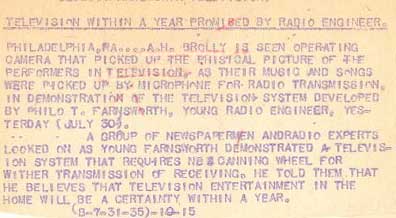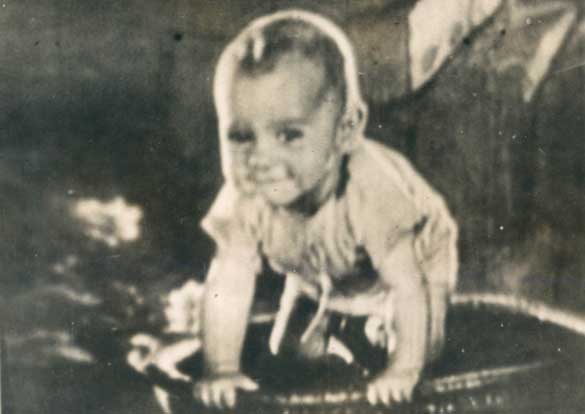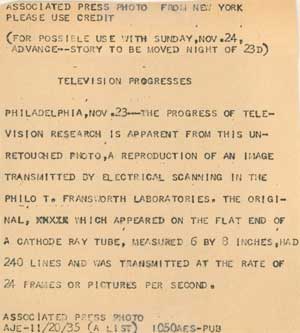Early Electronic Television Philo Farnsworth (1906 - 1971)Philo Taylor Farnsworth, specialist in cathode-ray tubes as applied to television, first became interested in electricity through a farm lighting system and its electric motors. Popular magazines told him of "such a thing called television," and he linked his life work to it. Farnsworth was described by a friend as "an omnivorous reader of scientific literature. While at Rigby (Idaho) high school, 1921-22, he delved into the molecular theory of matter, electrons, the Einstein theory, automobile engines, model airplanes and chemistry. He went to Glen Falls, Idaho in 1923 as an electrician on a railroad, then to Provo, Utah to work in a machine shop. He attended high school in Provo in the fall of 1923 and devoted spare time to study in the library maintained by Brigham Young University. In 1924 he enrolled in the University, but at the end of the second year, his father died and young Farnsworth left college to help support the family. He entered the radio business at Salt Lake City as a serviceman, but the shop failed and he went to work in the railroad yards. To Farnsworth, television was still "a day-dream, a day-dream only." He had no laboratory or facilities for research or money to buy equipment. One day in applying for a job in connection with the Salt Lake City Community Chest campaign, he met Leslie Gorrell and George Everson of San Francisco, who were conducting the drive. Farnsworth was hired. As the men became acquainted it was natural that they should learn about television from the young man. This was a turning point. Everson agreed to finance the idea. A laboratory was set up in Los Angeles. In October, 1926, with additional financial assistance, they established the Crocker Research Laboratories in San Francisco "to take all the moving parts out of television." The idea conceived in 1922 was brought to a practical result in 1927 when a sixty-line image of a dollar sign was the first image Farnsworth transmitted. (Note: Compare these dates to the 1923 start of Scotsman J. L. Baird on development of his mechanical TV system, and showing it for the first time in February, 1927, and Zworykin's first patent application for the basis of his iconoscope while a university graduate student in December, 1923. Farnsworth with his notion in 1922 at age 16 was truly a child prodigy by comparison.) The company was reorganized as Television Laboratories, Inc.; and later in May, 1929 was renamed Farnsworth Television, Inc. of California. Farnsworth's first application for a patent cover a complete electronic television system, including an "image dissector tube." was made January 7, 1927. The image dissector was used to scan the image for transmission. At the receiver, an "oscillite" tube reproduced the picture. An electron multiplier tube, which Farnsworth called a "multipactor," increased the sensitivity of the image dissector. In 1931 he moved his experiments to Wyndmoor, near Philadelphia, under an arrangement with Philco Radio Corporation. By 1932 that arrangement had fallen apart, and he continued his developement work in Philadelpia. In 1937 he began broadcasting on W3XPF in Philadelphia. In 1938 Farnsworth Radio and Television Corporation was organized and his television development moved to Fort Wayne, Indiana, with E.A. Nicholas as president, and Farnsworth as director of research. Here is a 1939 newspaper article about Farnsworth in Fort Wayne. Farnsworth's Image Dissector tube was the subject of a lengthy patent dispute with RCA, which was finally settled in 1939 when RCA agreed to pay royalties to Farnsworth. Courtesy of John Pinckney 1935 Press Photo
Philo Farnsworth, as he watched a televised picture of Joan Crawford as it appeared on the cathode tube in the receiving room at the Franklin Institute (1934) Courtesy of Harry Moore
|
